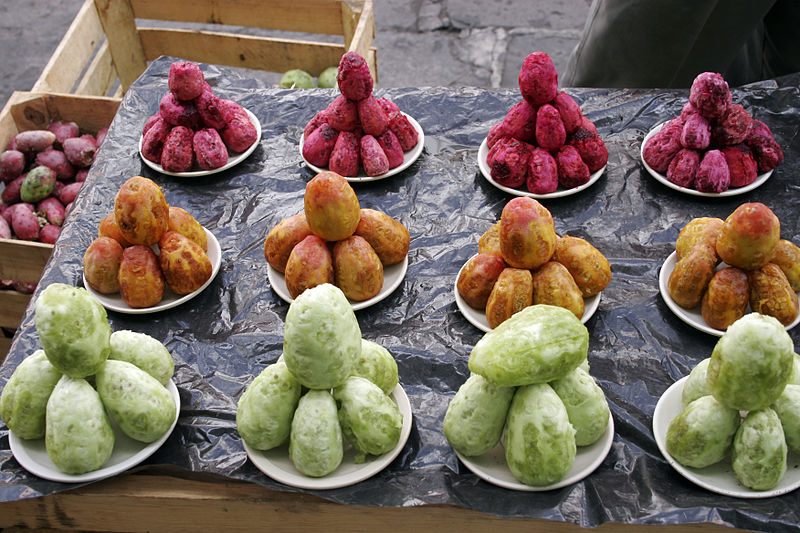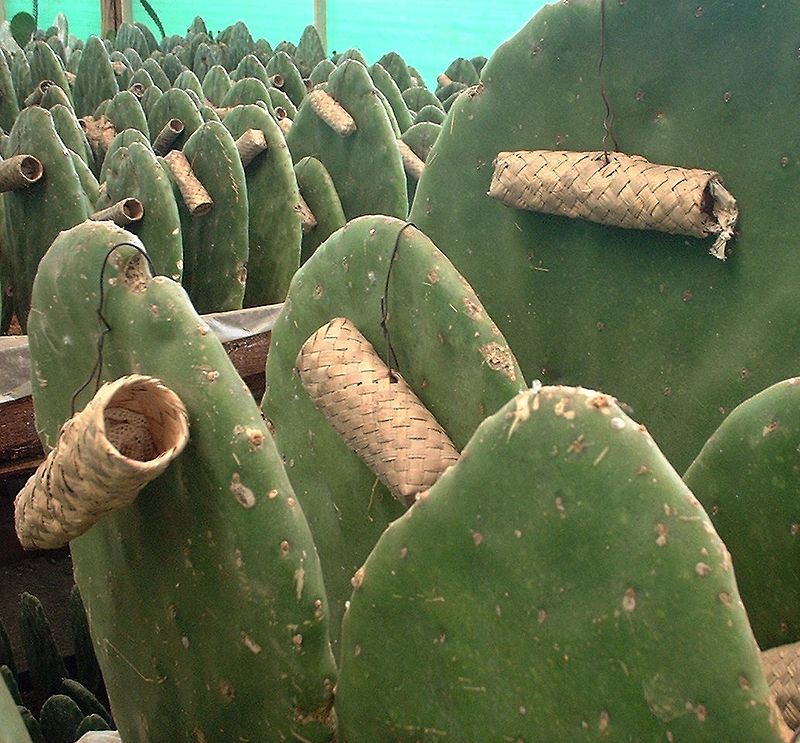Prickly Pear Cactus
Opuntia is a genus in the cactus family, Cactaceae.
The most common culinary
species is the Indian fig opuntia (O. ficus-indica). Most culinary uses of the
term "prickly pear" refer to this species. Prickly pears are also known as tuna
(fruit), sabra, nopal (paddle, plural nopales) from the Nahuatl word nōpalli for
the pads, or nostle, from the Nahuatl word nōchtli for the fruit; or paddle
cactus.
The genus is named for the Ancient Greek city of Opus,
where, according to Theophrastus, an edible plant grew which could be propagated
by rooting its leaves.
Like all true cactus species, prickly pears are
native only to the Americas, but they have been introduced to other parts of the
globe. Prickly pear species are found in abundance in Mexico, especially in the
central and western regions, and in the Caribbean islands (West Indies). In the
United States, prickly pears are native to many areas of the arid Western United
States, including the lower elevations of the Rocky Mountains, where species
such as Opuntia phaeacantha
and Opuntia polyacantha
become dominant, and to the desert Southwest, where several types are endemic.
Prickly pear cactus is also native to coastal beach scrub environments and low
open areas of the East Coast from Florida to Connecticut/Long Island (Opuntia
humifusa).
Prickly pears typically grow with flat, rounded cladodes
(also called platyclades) armed with two kinds of spines; large, smooth, fixed
spines and small, hairlike prickles called glochids, that easily penetrate skin
and detach from the plant. Many types of prickly pears grow into dense, tangled
structures.
Below, Prickly Pear fruit for
sale at a market, Zacatecas, Mexico
 The
fruit of prickly pears, commonly called cactus fruit, cactus fig, Indian fig,
nopales or tuna in Spanish, is edible, although it must be peeled carefully to
remove the small spines on the outer skin before consumption. If the outer layer
is not properly removed, glochids can be ingested, causing discomfort of the
throat, lips, and tongue, as the small spines are easily lodged in the skin.
Native Americans, like the Tequesta, would roll the fruit around in a suitable
medium (e.g. grit) to "sand" off the glochids. Alternatively, rotating the fruit
in the flame of a campfire or torch has been used to remove the glochids. Today,
parthenocarpic (seedless) cultivars are also available.
The
fruit of prickly pears, commonly called cactus fruit, cactus fig, Indian fig,
nopales or tuna in Spanish, is edible, although it must be peeled carefully to
remove the small spines on the outer skin before consumption. If the outer layer
is not properly removed, glochids can be ingested, causing discomfort of the
throat, lips, and tongue, as the small spines are easily lodged in the skin.
Native Americans, like the Tequesta, would roll the fruit around in a suitable
medium (e.g. grit) to "sand" off the glochids. Alternatively, rotating the fruit
in the flame of a campfire or torch has been used to remove the glochids. Today,
parthenocarpic (seedless) cultivars are also available.

Dactylopius coccus is a scale insect from which
cochineal dye is derived. D. coccus itself is native to tropical and subtropical
South America and Mexico. This insect, a primarily sessile parasite, lives on
cacti from the genus Opuntia, feeding on moisture and nutrients in the cactus
sap. The insect produces carminic acid, which deters predation by other insects.
The carminic acid can be extracted from the insect's body and eggs to make the
red dye.
Cochineal is used primarily as a red food colouring
and for cosmetics. The cochineal dye was used by the Aztec and Maya peoples of
Central and North America. Produced almost exclusively in Oaxaca, Mexico, by
indigenous producers, cochineal became Mexico's second-most valued export after
silver. The dyestuff was consumed throughout Europe, and was so highly valued,
its price was regularly quoted on the London and Amsterdam Commodity Exchanges.
Right image, traditional "Zapotec nest" farming of the
cochineal scale insect on O. ficus-indica, Oaxaca
Information culled from Wikipedia. So I can only guess as
to the correctness of the information.
 The
fruit of prickly pears, commonly called cactus fruit, cactus fig, Indian fig,
nopales or tuna in Spanish, is edible, although it must be peeled carefully to
remove the small spines on the outer skin before consumption. If the outer layer
is not properly removed, glochids can be ingested, causing discomfort of the
throat, lips, and tongue, as the small spines are easily lodged in the skin.
Native Americans, like the Tequesta, would roll the fruit around in a suitable
medium (e.g. grit) to "sand" off the glochids. Alternatively, rotating the fruit
in the flame of a campfire or torch has been used to remove the glochids. Today,
parthenocarpic (seedless) cultivars are also available.
The
fruit of prickly pears, commonly called cactus fruit, cactus fig, Indian fig,
nopales or tuna in Spanish, is edible, although it must be peeled carefully to
remove the small spines on the outer skin before consumption. If the outer layer
is not properly removed, glochids can be ingested, causing discomfort of the
throat, lips, and tongue, as the small spines are easily lodged in the skin.
Native Americans, like the Tequesta, would roll the fruit around in a suitable
medium (e.g. grit) to "sand" off the glochids. Alternatively, rotating the fruit
in the flame of a campfire or torch has been used to remove the glochids. Today,
parthenocarpic (seedless) cultivars are also available.